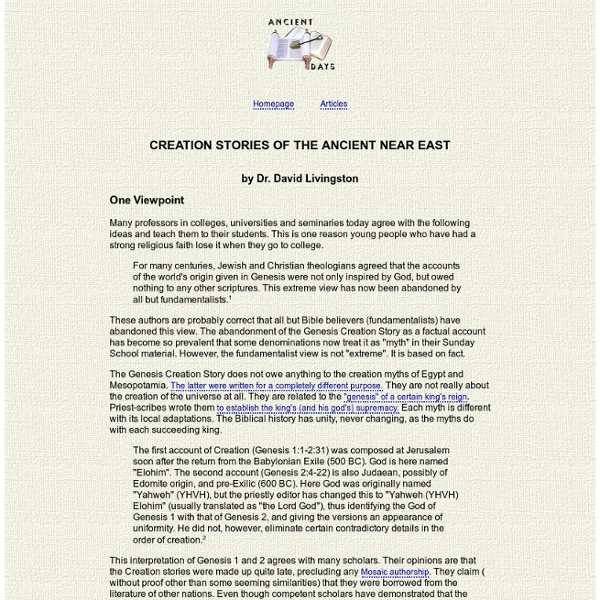Comparison of Genesis with Creation Stories of the Ancient Near East

Ancient Days :: Who Were the Sons of God in Genesis 6? :: by David Livingston
In Genesis 6:1-8 we read about some persons who may be a pre-Flood link between the Bible and the cultures of the ancient Near East. They are the "sons of the gods." The biblical reference to them should have some relationship with historical fact. Suggested Meanings for the "sons of god" Who actually were the "sons of god?" Another interpretation is that they were the sons of Seth, the godly line. The third possibility is that of rabbinical Jewish interpretation. Perhaps a combination of the first and third is the best explanation. A New Interpretation A new interpretation has been suggested by Meredith Kline (in The Westminster Theological Journal, May 1962). The fact that an historical theme so prominently treated in the Sumero-Babylonian epic tradition finds no counterpart (or connection with) Genesis 3-6 according to standard (traditional) interpretations is itself good reason to suspect that these interpretations have been missing the point (p. 199). Divine Kingship What is it? 1.
Jewish angelic hierarchy
Angels in Judaism (angel: Hebrew: מַלְאָךְ mal’āḵ, plural mal’āḵīm) appear throughout the Hebrew Bible, Talmud, Rabbinic literature, and traditional Jewish liturgy. They are categorized in different hierarchies. Maimonides[edit] Maimonides, in his Mishneh Torah or Yad ha-Chazakah: Yesodei ha-Torah, counts ten ranks of angels in the Jewish angelic hierarchy, beginning from the highest: Kabbalah[edit] According to the Golden Dawn's interpretation of the Kabbalah, there are ten archangels, each commanding one of the choirs of angels and corresponding to one of the Sephirot. See also[edit] Hermetic Order of the Golden Dawn References[edit] External links[edit]
e2fc45c0f67df98409ee4f2c9da31f28
nine grades of angels
The world tree or mountain are conditional symbols of a centre where there is the global vertical axis, that in aggregate with a horizontal surface of the world forms coordinates of world space. Namely vertical global axis corresponds with the central numerological number 5 which is in the centre of magic square of nine numbers in a context of numerology, and other numbers of the magic square symbolize horizontal measurements of the world. Horizontal and vertical measurements of the world are congruous, namely vertical axis has numerical gradation which are projections of numbers on a horizontal surface. The following table shows the summary chart in which identical names of angelic grades are incorporated and different names are harmonized with hierarchy of angels agrees Pseudo-Dionysius the Areopagite. The following page compares physiognomy of a human face to circles of the universe in the Divine Comedy of Dante Alighieri. previous - upwards - following
Eastern Christianity
Christian traditions originating from Greek- and Syriac-speaking populations Major Eastern Christian bodies include the Eastern Orthodox Church and the Oriental Orthodox Churches, along with those groups descended from the historic Church of the East, as well as the Eastern Catholic Churches (which have either re-established or always retained communion with Rome and maintain Eastern liturgies), and the Eastern Protestant churches[2] (which are Protestant in theology but Eastern in cultural practice). The various Eastern churches do not normally refer to themselves as "Eastern", with the exception of the Assyrian Church of the East and the Ancient Church of the East. Historically, after the loss of the Levant in the 7th century to the Islamic Sunni Caliphate, the term Eastern Church was used for the Greek Church centred in Byzantium, in contrast with the (Western) Latin Church, centered on Rome, which uses the Latin liturgical rites. Families of churches[edit] Oriental Orthodoxy[edit]
Jonathon's good Theology | Just another Edublogs.org site
Internet Sacred Text Archive Home
Aztec Calendar
Asatru Update
Asatru Folk Assembly - Home
Daily Hávamál | Huginn's Heathen Hof | Page 16
Original-Ósnjallr maðrhyggsk munu ey lifaef hann við víg varasken elli gefrhonum engi friðþótt honum geirar gefi Translation-The cowardly manthinks he will live foreverif he just avoids conflictbut old age gives him no peacethough spears have spared him-Hávamál: Stanza 16 Much like the preceding stanza (15), this verse gives us a glimpse into ancient Germanic philosophy. In fifteen, Odin told us that we should be both cheerful and generous until death finds us. Original-Kópir afglapier til kynnis kømrþylsk hann umbeða þrumiralt er sennef hann sylg um getruppi er þá geð guma Translation-The foolish man stareshovering about the edges of the feastHe mumbles to himself,or just sits silently.But once he has a few drinks,everybody will know what a fool he is. Today’s stanza needs little explanation. Original-Þagalt ok hugaltskyli þjóðans barnok vígdjarft veraglaðr ok reifrskyli gumna hverrunz sínn bíðr bana This stanza shifts us from “advice about life”, to “advice about how to live”.
Related:
Related:



